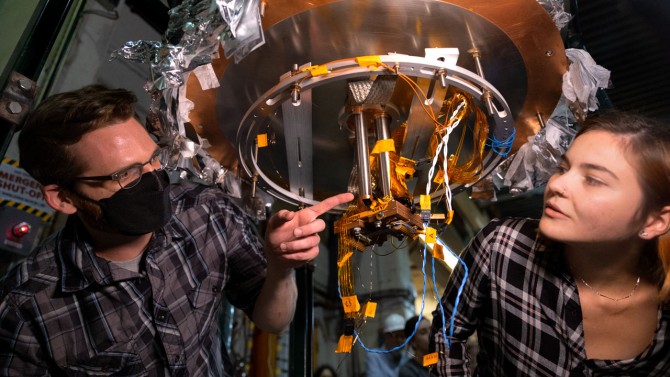Accelerator physics has revealed hidden universes, from the Higgs boson to what can be seen on a CT scan - and much of that progress is thanks to work done in an unassuming building tucked away on Cornell's North Campus: Newman Lab.
For 75 years, physicists in Newman Lab have pushed the limits of accelerator physics, inventing new techniques and building ever more advanced equipment to explore the boundaries of the known.
"There are very few universities that do accelerator research. Cornell is a leader among them," said Ritchie Patterson, the Helen T. Edwards Professor of Physics in the College of Arts and Sciences and director of the Center for Bright Beams.
Newman owes its existence, at least in part, to Nobel Laureate Hans Bethe. As leader of the theory group for the Manhattan Project - which designed and built the atomic bomb - Bethe enticed many of his collaborators at Los Alamos to join him in Cornell's Department of Physics (A&S) after the war. The illustrious group included Dale Corson and Richard Feynman. But there was no ideal space for the physicists to realize their accelerator dreams.
"Hans Bethe threatened to accept Columbia's job offer if Cornell didn't build him a proper lab," said Peter Lepage, the Andrew H. and James S. Tisch Distinguished University Professor Emeritus (A&S). "So: Newman Lab."
Dedicated on Oct 7, 1948, the facility included big machine and electronic shops, and the highest ceiling on campus, 28 feet, 7 inches, to accommodate a crane needed to move accelerator equipment. A clean room was later added.
But the first accelerator the researchers built in Newman, a 300 MeV synchrotron to accelerate electrons to make X-rays to bombard heavier particles in order to explore what was inside, wouldn't work.
Bethe asked Robert Wilson, the head of the experimental group at Los Alamos, to come to Cornell and help as director of Newman Lab. True to his reputation, Wilson got the accelerator working. But he didn't stop there.
"He couldn't stop building accelerators. As soon as he finished one, he started a next bigger one," said Maury Tigner, Ph.D. '64, the Hans A. Bethe Professor Emeritus (A&S).
The 300MeV machine was followed by a 1.3 GeV, which incorporated parts from the first, as did subsequent generations. The next accelerator, a 2.2 GeV, spanned the entirety of Newman Lab's basement.
For his next accelerator, Wilson needed more space, which led in 1968 to the construction of a 10 GeV synchrotron under Robison Alumni Fields and the associated building, Wilson Lab, which evolved into the Cornell High-Energy Synchrotron Source (CHESS).
Though Cornell's accelerator outgrew Newman Lab, the building's importance continues.
"Particle accelerators intersect with our daily lives right now, and will more frequently in the future," said Jared Maxson, M.S. '12, Ph.D. '15, the Joyce A. Yelencsics Rosevear '65 and Frederick M. Rosevear '64 Assistant Professor of physics (A&S). "Accelerators are used for treatment of cancer in hospitals all around the world. Increasingly, electron accelerators are being used for wastewater treatment at the scale of cities."
Accelerators could also be used with wastewater to kill parasites, which can survive current treatment methods. They could also get rid of "forever" chemicals. Such efficient on-site decontamination isn't possible with the current generation of accelerators, but Maxson and other Cornell researchers are considering the problem.
Another innovation pioneered at Cornell could impact the energy crisis by enabling accelerators to reuse the vast amounts of energy they require to operate.
The concept of reclaiming the energy of a used electron beam to accelerate the next beam of particles - instead of dumping it after the experiment - was first suggested by Tigner in a 1965 paper, but developing the technology took another four decades of research, much of it taking place at Cornell. Construction of the Cornell-Brookhaven Energy Recovery Linac (ERL) Test Accelerator facility, known as CBETA, was completed in 2019.
The technology could also contribute to more efficient manufacturing of computer chips, which are made using ultraviolet light lithography, which requires huge amounts of energy.
"As chips get smaller, we need to 'write' them with ever shorter wavelengths of light, and these advanced light sources consume a lot of power. We're looking at using acceleration to create extreme UV light using the energy recovery technology that was pioneered at Cornell," Maxson said.
According to Patterson, the energy footprint of chip fabrication could be reduced by as much as a factor of 10 by the use of high-power beams generated by the superconducting cavities being developed at Cornell.
"We're always keeping our eye on the future and are ready to go after things that are exciting," said Patterson.
Read the full story on the College of Arts and Sciences website.
Linda B. Glaser is the news and media relations manager for the College of Arts and Sciences.







